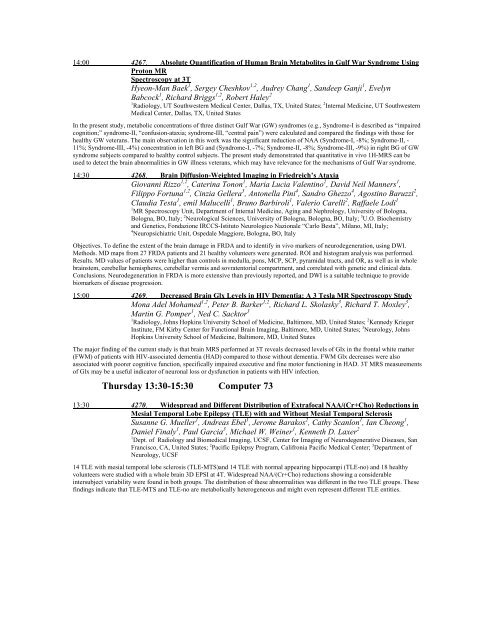ELECTRONIC POSTER - ismrm
ELECTRONIC POSTER - ismrm
ELECTRONIC POSTER - ismrm
Create successful ePaper yourself
Turn your PDF publications into a flip-book with our unique Google optimized e-Paper software.
14:00 4267. Absolute Quantification of Human Brain Metabolites in Gulf War Syndrome Using<br />
Proton MR<br />
Spectroscopy at 3T<br />
Hyeon-Man Baek 1 , Sergey Cheshkov 1,2 , Audrey Chang 1 , Sandeep Ganji 1 , Evelyn<br />
Babcock 1 , Richard Briggs 1,2 , Robert Haley 2<br />
1 Radiology, UT Southwestern Medical Center, Dallas, TX, United States; 2 Internal Medicine, UT Southwestern<br />
Medical Center, Dallas, TX, United States<br />
In the present study, metabolic concentrations of three distinct Gulf War (GW) syndromes (e.g., Syndrome-I is described as “impaired<br />
cognition;” syndrome-II, “confusion-ataxia; syndrome-III, “central pain”) were calculated and compared the findings with those for<br />
healthy GW veterans. The main observation in this work was the significant reduction of NAA (Syndrome-I, -8%; Syndrome-II, -<br />
11%; Syndrome-III, -4%) concentration in left BG and (Syndrome-I, -7%; Syndrome-II, -8%; Syndrome-III, -9%) in right BG of GW<br />
syndrome subjects compared to healthy control subjects. The present study demonstrated that quantitative in vivo 1H-MRS can be<br />
used to detect the brain abnormalities in GW illness veterans, which may have relevance for the mechanisms of Gulf War syndrome.<br />
14:30 4268. Brain Diffusion-Weighted Imaging in Friedreich’s Ataxia<br />
Giovanni Rizzo 1,2 , Caterina Tonon 1 , Maria Lucia Valentino 2 , David Neil Manners 1 ,<br />
Filippo Fortuna 1,2 , Cinzia Gellera 3 , Antonella Pini 4 , Sandro Ghezzo 4 , Agostino Baruzzi 2 ,<br />
Claudia Testa 1 , emil Malucelli 1 , Bruno Barbiroli 1 , Valerio Carelli 2 , Raffaele Lodi 1<br />
1 MR Spectroscopy Unit, Department of Internal Medicine, Aging and Nephrology, University of Bologna,<br />
Bologna, BO, Italy; 2 Neurological Sciences, University of Bologna, Bologna, BO, Italy; 3 U.O. Biochemistry<br />
and Genetics, Fondazione IRCCS-Istituto Neurologico Nazionale “Carlo Besta”, Milano, MI, Italy;<br />
4 Neuropsichiatric Unit, Ospedale Maggiore, Bologna, BO, Italy<br />
Objectives. To define the extent of the brain damage in FRDA and to identify in vivo markers of neurodegeneration, using DWI.<br />
Methods. MD maps from 27 FRDA patients and 21 healthy volunteers were generated. ROI and histogram analysis was performed.<br />
Results. MD values of patients were higher than controls in medulla, pons, MCP, SCP, pyramidal tracts, and OR, as well as in whole<br />
brainstem, cerebellar hemispheres, cerebellar vermis and sovratentorial compartment, and correlated with genetic and clinical data.<br />
Conclusions. Neurodegeneration in FRDA is more extensive than previously reported, and DWI is a suitable technique to provide<br />
biomarkers of disease progression.<br />
15:00 4269. Decreased Brain Glx Levels in HIV Dementia: A 3 Tesla MR Spectroscopy Study<br />
Mona Adel Mohamed 1,2 , Peter B. Barker 1,2 , Richard L. Skolasky 3 , Richard T. Moxley 3 ,<br />
Martin G. Pomper 1 , Ned C. Sacktor 3<br />
1 Radiology, Johns Hopkins University School of Medicine, Baltimore, MD, United States; 2 Kennedy Krieger<br />
Institute, FM Kirby Center for Functional Brain Imaging, Baltimore, MD, United States; 3 Neurology, Johns<br />
Hopkins University School of Medicine, Baltimore, MD, United States<br />
The major finding of the current study is that brain MRS performed at 3T reveals decreased levels of Glx in the frontal white matter<br />
(FWM) of patients with HIV-associated dementia (HAD) compared to those without dementia. FWM Glx decreases were also<br />
associated with poorer cognitive function, specifically impaired executive and fine motor functioning in HAD. 3T MRS measurements<br />
of Glx may be a useful indicator of neuronal loss or dysfunction in patients with HIV infection.<br />
Thursday 13:30-15:30 Computer 73<br />
13:30 4270. Widespread and Different Distribution of Extrafocal NAA/(Cr+Cho) Reductions in<br />
Mesial Temporal Lobe Epilepsy (TLE) with and Without Mesial Temporal Sclerosis<br />
Susanne G. Mueller 1 , Andreas Ebel 1 , Jerome Barakos 2 , Cathy Scanlon 1 , Ian Cheong 1 ,<br />
Daniel Finaly 1 , Paul Garcia 3 , Michael W. Weiner 1 , Kenneth D. Laxer 2<br />
1 Dept. of Radiology and Biomedical Imaging, UCSF, Center for Imaging of Neurodegenerative Diseases, San<br />
Francisco, CA, United States; 2 Pacific Epilepsy Program, Califronia Pacific Medical Center; 3 Department of<br />
Neurology, UCSF<br />
14 TLE with mesial temporal lobe sclerosis (TLE-MTS)and 14 TLE with normal appearing hippocampi (TLE-no) and 18 healthy<br />
volunteers were studied with a whole brain 3D EPSI at 4T. Widespread NAA/(Cr+Cho) reductions showing a considerable<br />
intersubject variability were found in both groups. The distribution of these abnormalities was different in the two TLE groups. These<br />
findings indicate that TLE-MTS and TLE-no are metabolically heterogeneous and might even represent different TLE entities.
















